The Ultimate Guide to Guppies Tank Temperature
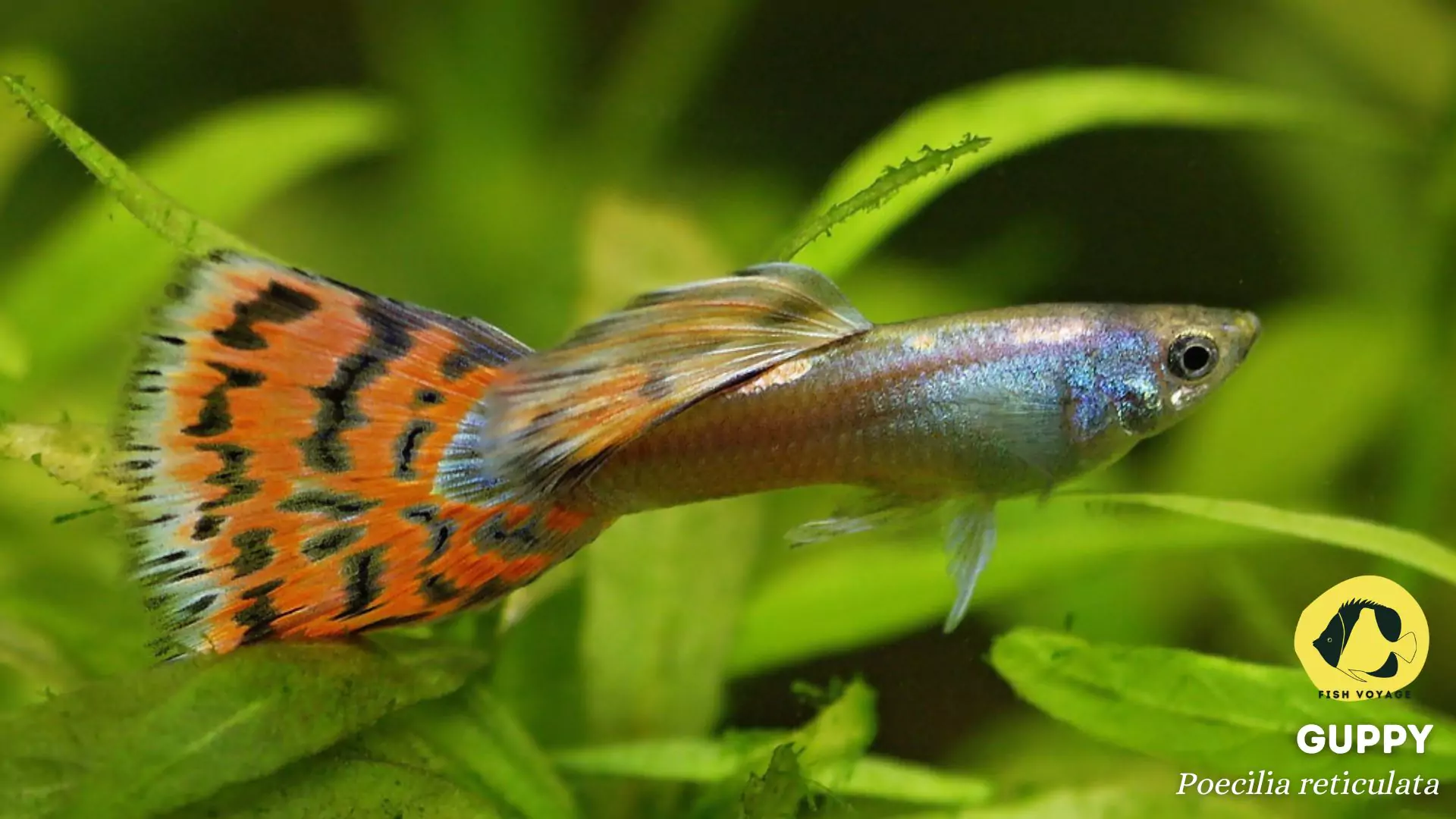
Ensuring the optimal temperature in your guppy tank is paramount to the health and well-being of your aquatic companions. Guppies, known for their vibrant colors and lively personalities, are highly sensitive to fluctuations in temperature. Just like any living creature, maintaining a stable and suitable environment is essential for their overall health. In this comprehensive guide, we’ll delve into the significance of temperature regulation for guppies, exploring how it affects their behavior, immune system, and reproductive health. By understanding and controlling this crucial aspect of guppy care, you can provide your fish with the ideal conditions to thrive and flourish in their aquatic habitat.
Understanding Guppy Tank Temperature
Natural Habitat of Guppies
- Guppies, native to the tropical regions of South America and the Caribbean, inhabit freshwater environments characterized by warm temperatures.
- Found in densely vegetated areas such as streams, rivers, and ponds, guppies have adapted to thrive in waters with temperatures typically ranging from 74°F to 82°F (23°C to 28°C).
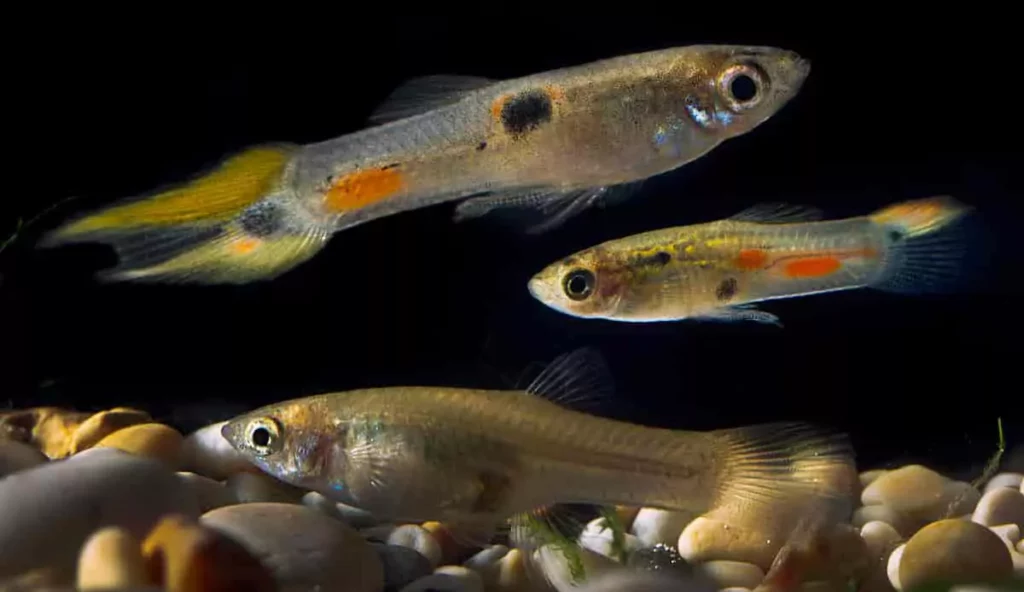
Temperature Conditions for Thriving
- Guppies are ectothermic creatures, meaning their body temperature fluctuates based on their surroundings.
- In their natural habitat, guppies display optimal health and reproductive behaviors within the temperature range mentioned above.
- Warmer temperatures stimulate their metabolism, enhancing digestion and promoting overall activity levels.
Impact of Temperature Fluctuations
- Temperature fluctuations outside the recommended range can significantly impact guppies’ health and behavior.
- Sudden drops in temperature can weaken their immune system, making them more susceptible to diseases such as ich (white spot disease) and fungal infections.
- Conversely, prolonged exposure to high temperatures can lead to stress, reduced appetite, and even heatstroke, ultimately compromising their well-being.
Behavioral Responses to Temperature Changes
- Guppies exhibit distinct behavioral responses to temperature fluctuations.
- In colder water, they may become lethargic, seeking warmer areas of the tank or slowing down their movements to conserve energy.
- Conversely, in warmer water, guppies may display heightened activity levels, including increased swimming speed and breeding behaviors.
By understanding the natural habitat of guppies and the impact of temperature fluctuations on their health and behavior, aquarists can effectively create and maintain an environment that mirrors their native conditions, ensuring the well-being of these captivating aquatic creatures.
Ideal Temperature Range for Guppies
Recommended Temperature Range
- Guppies thrive in water temperatures typically ranging between 74°F to 82°F (23°C to 28°C).
- This temperature range closely mimics their natural habitat in tropical regions, ensuring optimal health and vitality.
Importance of Consistency
- Maintaining a consistent temperature within the recommended range is crucial for guppy health.
- Fluctuations outside this range can cause stress and compromise their immune system, making them more susceptible to diseases.
- Consistency in temperature also promotes stable metabolic rates, digestion, and overall well-being among guppies.
Behavioral Benefits
- Guppies display more active and vibrant behaviors when kept within their ideal temperature range.
- They are more likely to engage in natural behaviors such as exploring their environment, foraging for food, and displaying colorful patterns.
Reproductive Success
- Temperature plays a significant role in guppy breeding behavior and reproductive success.
- Consistent temperatures within the recommended range encourage breeding behaviors, leading to healthier offspring and sustainable populations.
Avoiding Extremes
- Extreme temperatures, whether too high or too low, can have detrimental effects on guppies.
- Temperatures below 74°F (23°C) can slow down metabolism and hinder growth, while temperatures above 82°F (28°C) can lead to stress, oxygen depletion, and increased susceptibility to diseases.
Maintaining the recommended temperature range ensures the overall health, vitality, and reproductive success of guppies in the aquarium environment, allowing aquarists to enjoy these captivating fish to the fullest.
Factors Affecting Tank Temperature
Room Temperature
- The ambient temperature of the room where the guppy tank is located can directly impact the water temperature.
- Warmer rooms may lead to higher water temperatures, while cooler rooms can result in lower temperatures.
- To maintain a stable tank temperature, consider the room’s temperature fluctuations and adjust accordingly with heating or cooling equipment.
Tank Size
- The size of the guppy tank influences how quickly it heats up or cools down.
- Smaller tanks tend to experience temperature fluctuations more rapidly than larger tanks due to their smaller volume of water.
- Larger tanks provide more stability in temperature, but still require proper heating equipment to maintain the ideal range.
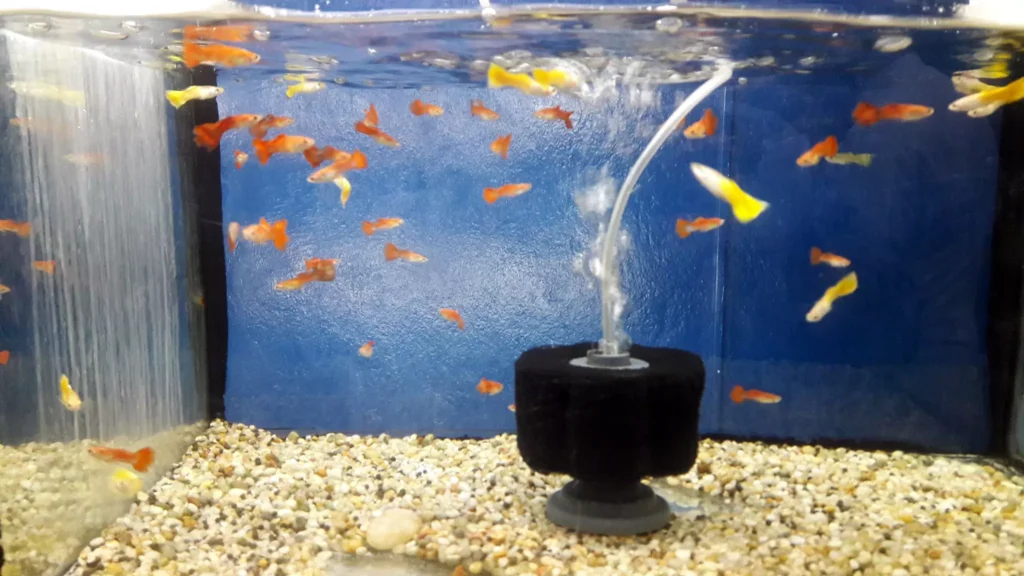
Lighting
- Intense lighting, such as direct sunlight or powerful aquarium lights, can increase water temperature.
- Limiting the duration and intensity of lighting can help regulate temperature fluctuations.
- Consider using LED lights that emit less heat or installing shades to reduce direct sunlight exposure.
Heating Equipment
- A reliable aquarium heater is essential for maintaining consistent water temperature, especially in colder environments.
- Choose a heater with adjustable temperature settings and ensure it is appropriate for the size of your tank.
- Regularly check and calibrate the heater to prevent malfunctions or overheating.
Tips for Temperature Control
- Use a quality aquarium thermometer to monitor water temperature regularly.
- Invest in a reliable aquarium heater with built-in thermostat controls to maintain stability.
- Consider using a backup heater or thermostat to ensure redundancy in case of equipment failure.
- Avoid placing the tank near drafty windows or doors to minimize temperature fluctuations.
- Insulate the tank with a tank cover or insulation material to retain heat and prevent rapid cooling.
By understanding and addressing the various factors that influence tank temperature, aquarists can effectively control and stabilize fluctuations, providing a consistent and comfortable environment for their guppies.
Monitoring and Adjusting Tank Temperature
Importance of Regular Monitoring
- Regularly monitoring the temperature of the guppy tank is essential for maintaining a healthy environment.
- Fluctuations in temperature, even minor ones, can stress guppies and compromise their immune system, leading to potential health issues.
- Monitoring temperature fluctuations allows aquarists to detect and address any deviations promptly, ensuring the well-being of their guppies.
Using Reliable Thermometers
- Invest in a reliable aquarium thermometer to accurately measure water temperature.
- Choose thermometers specifically designed for aquarium use, such as digital or glass thermometers, for precise readings.
- Place the thermometer in a central location within the tank, away from heaters or areas with temperature variations, to obtain an accurate representation of overall water temperature.
Selecting Quality Heaters
- Choose a high-quality aquarium heater with adjustable temperature settings and built-in thermostat controls.
- Ensure the heater is suitable for the size of your tank to provide adequate heating.
- Opt for heaters with safety features such as automatic shut-off to prevent overheating and ensure the safety of your guppies.
Troubleshooting Temperature Adjustments
- If the temperature falls below the recommended range, increase the heater’s temperature setting gradually to raise the water temperature.
- Avoid making abrupt adjustments to prevent temperature shock to the guppies.
- Monitor the temperature closely after adjusting to ensure it stabilizes within the optimal range.
- If the temperature exceeds the recommended range, consider reducing the heater’s temperature setting or adjusting the room temperature to lower the water temperature gradually.
Emergency Measures
- In case of sudden temperature fluctuations or equipment failure, prepare an emergency plan to mitigate potential risks to your guppies.
- Have a backup heater or alternative heating method available to maintain temperature stability.
- Monitor the guppies closely for signs of stress or illness, and take prompt action to address any issues that arise.
By regularly monitoring the temperature of the guppy tank, using reliable thermometers and heaters, and implementing troubleshooting measures when necessary, aquarists can ensure a stable and optimal environment for their guppies’ health and well-being.
Tips for Keeping Guppies Comfortable
Provide Hiding Spots
- Incorporate plants, driftwood, and decorations into the aquarium to create hiding spots for guppies.
- Hiding spots offer shelter and security, reducing stress levels and promoting natural behavior among guppies.
- Ensure hiding spots are distributed evenly throughout the tank to accommodate all guppies and minimize territorial disputes.
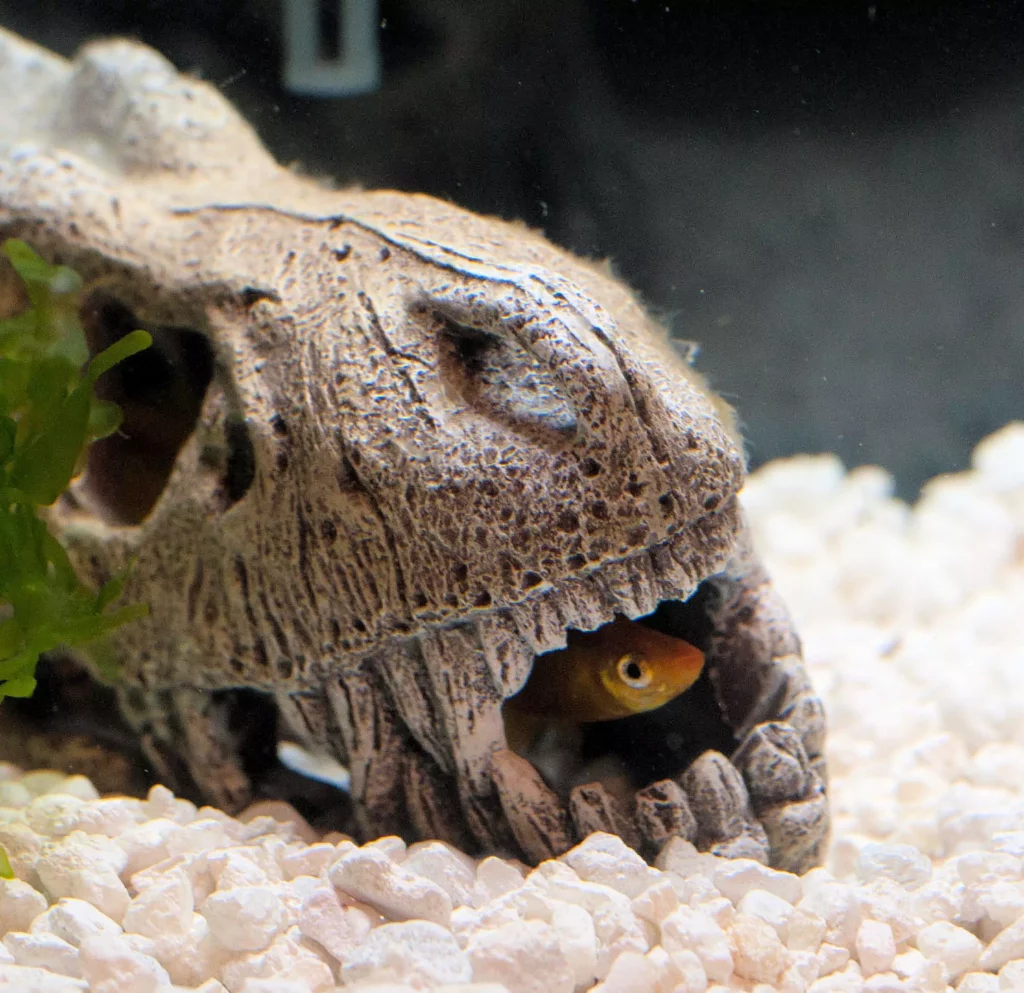
Maintain Water Quality
- Regularly test water parameters such as pH, ammonia, nitrite, and nitrate levels to ensure optimal water quality.
- Perform partial water changes weekly to remove toxins and replenish essential minerals.
- Use a reliable filtration system to remove waste and maintain a clean and healthy aquatic environment for guppies.
Emphasize Temperature Control
- Maintain a stable temperature within the recommended range (74°F to 82°F or 23°C to 28°C) to prevent stress-related illnesses and promote overall well-being.
- Consistent temperature levels enhance guppies’ immune system, reducing their susceptibility to diseases such as ich and fungal infections.
- Optimal temperature conditions also contribute to vibrant colors, active behavior, and successful breeding among guppies.
Offer Varied Diet
- Provide a balanced diet consisting of high-quality flake, pellet, and frozen foods to meet the nutritional needs of guppies.
- Offer a variety of food options such as live or frozen brine shrimp, bloodworms, and vegetable matter to ensure dietary diversity.
- Avoid overfeeding and remove any uneaten food promptly to maintain water quality and prevent digestive issues.
Monitor Tank Mates
- Choose compatible tank mates that exhibit peaceful behavior and similar environmental requirements to guppies.
- Avoid aggressive or territorial species that may intimidate or harm guppies, leading to stress and decreased well-being.
- Monitor guppy interactions with tank mates closely and intervene if any signs of aggression or bullying occur.
By implementing these tips, aquarists can create a comfortable and enriching environment for their guppies, fostering optimal health, vibrant colors, and natural behaviors.
Conclusion
In conclusion, maintaining the optimal temperature in your guppy tank is paramount for the health and happiness of your aquatic companions. By understanding the natural habitat of guppies, the ideal temperature range they thrive in, and the factors influencing tank temperature, you can create a stable and comfortable environment for your fish. Consistent temperature levels not only prevent stress-related illnesses and promote vibrant colors but also encourage natural behaviors and successful breeding. As responsible aquarists, let’s prioritize the well-being of our guppies by ensuring they are provided with the right temperature conditions, thus enhancing their overall quality of life.
Additional Resources
Books on Guppy Care
- How to Breed Guppies? by Victoria Vet.
- Guppy Care & Breeding for Beginners by N. T. Gore.
- Guppy Care: The Complete Guide by Tabitha Jones.
Recommended Products
- Orlushy Submersible Aquarium Heater: Ensure precise temperature control with this reliable aquarium heater, equipped with thermostat controls and safety features.
- Paizoo Digital Aquarium Thermometer: Monitor water temperature accurately with this digital aquarium thermometer, designed for easy installation and accurate readings.
- Sabtach Brine Shrimp: Provide a nutritious treat for your guppies with live brine shrimp, rich in essential nutrients and protein for optimal health and vitality.
- API Freshwater Master Test Kit: Maintain optimal water quality with this comprehensive aquarium water test kit, allowing you to monitor pH, ammonia, nitrite, and nitrate levels.
Frequently Asked Questions (FAQs)
1. What is the ideal temperature range for guppies in a tank?
The ideal temperature range for guppies in a tank is typically between 74°F to 82°F (23°C to 28°C). Maintaining consistent temperatures within this range is crucial for their health and well-being.
2. How can I monitor the temperature in my guppy tank?
You can monitor the temperature in your guppy tank using a reliable aquarium thermometer. Place the thermometer in a central location within the tank away from heaters or areas with temperature variations for accurate readings.
3. What should I do if the temperature in my guppy tank is too low?
If the temperature in your guppy tank is too low, consider increasing the temperature gradually using a reliable aquarium heater with adjustable temperature settings. Avoid making abrupt adjustments to prevent temperature shock to your guppies.
4. Can temperature fluctuations affect the health of my guppies?
Yes, temperature fluctuations can significantly impact the health of your guppies. Sudden drops or spikes in temperature can stress your fish, weaken their immune system, and make them more susceptible to diseases.
5. Are there any tips for preventing temperature fluctuations in my guppy tank?
To prevent temperature fluctuations in your guppy tank, ensure proper insulation, avoid placing the tank near drafty windows or doors, use a reliable aquarium heater with thermostat controls, and monitor the room temperature regularly.


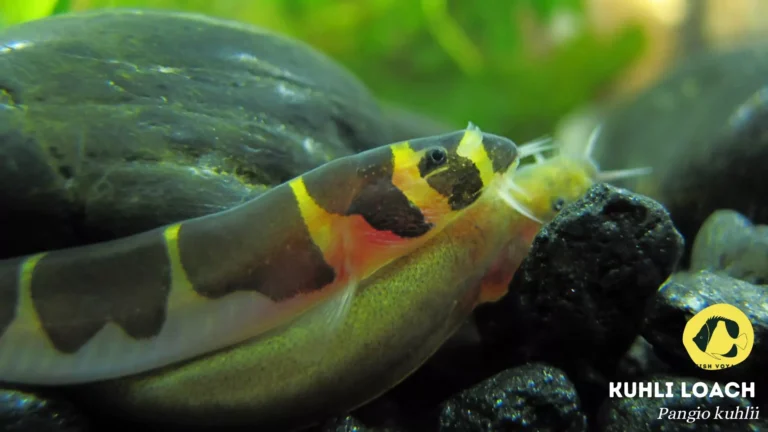
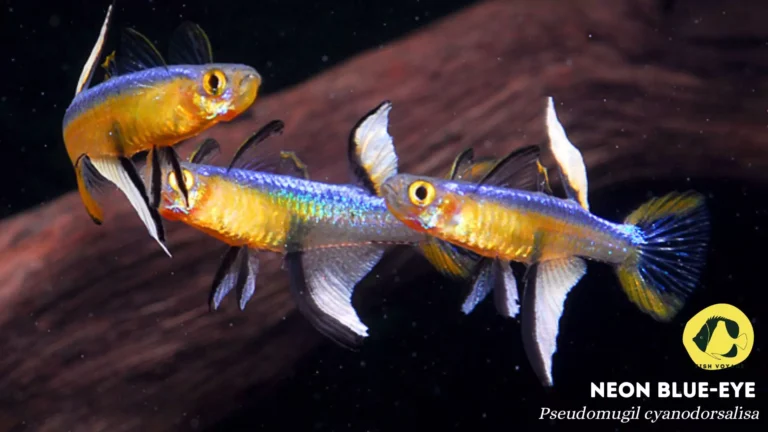

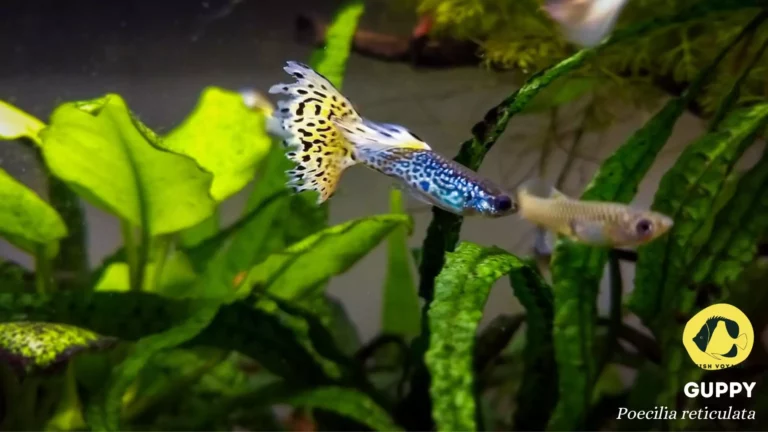
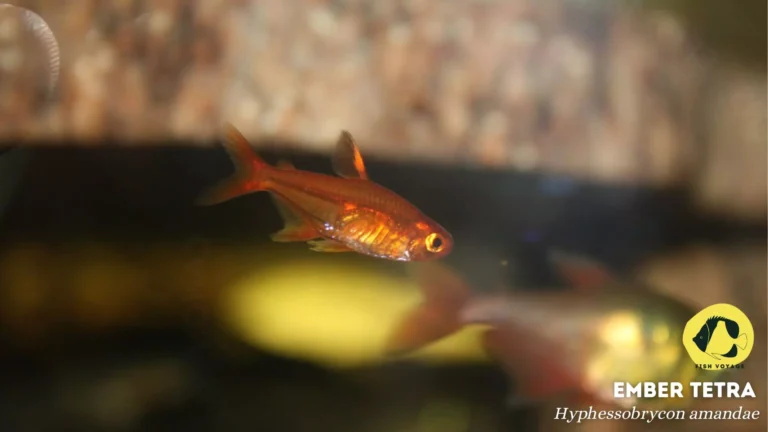
Normally I do not read article on blogs however I would like to say that this writeup very forced me to try and do so Your writing style has been amazed me Thanks quite great post